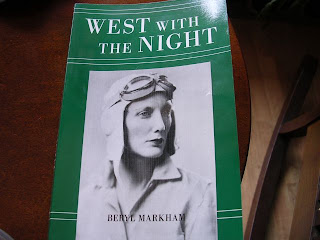
I happened on Outside Magazines 25 Best Adventure Stories of the Last 100 Years the other day. I can't resist a real-life adventure story so was interested on their take. A few I had already read but there was also plenty that I hadn't so I paid a visit to Amazon.com.
In a very short time I had three of the books in my possession, including West with the Night by Beryl Markham. I had never heard of her but the magazine's description of her writing enticed me to take the plunge.
And what a plunge it was. Beryl Markham was born Beryl Clutterbuck in England in 1902 and when she was four years old her father moved the family to British ruled Kenya where he started a mill and raised thoroughbreds for racing. Her mother apparently hated it and moved quickly back to England. Beryl never mentions her once in this book although her father plays a big part in her story.
Just before she is 18 years old a three year drought forces her father to sell the farm and move to Peru. Beryl opts to stay in Africa where she becomes a fledgling race horse trainer. She achieves success on the track but her imagination is soon captured by the airplane and very likely the pilot, Tom Black. He teaches her to fly and soon she becomes one of the most respected pilots in Africa.
She branches out her business from delivering packages and people to reconnoitering game animals for safaris. The adventures she recounts are just mind boggling and it is difficult to imagine the dangers she regularly encountered. Especially in the 1920's and 1930's when women hadn't even come close to social equality with men.
You will find as you read that she is acquainted with an amazing assortment of famous people. They keep popping up in her story and you won't be able to resist Googling them to find out who they are. On the back cover of the book is a letter from Ernest Hemingway to his friend Maxwell Perkins recommending the book and saying "she can write rings around all of us who consider ourselves writers." He also says in the letter that he knew her fairly well while he was in Africa and the great writer doesn't even get a mention in her book.
Interestingly it was the letter that got the book republished in 1983 when a California restaurateur was reading a collection of Hemingway's letters and discovered the one with the book recommendation. Ms. Markham, now elderly and living in poverty in Africa, was rediscovered after the book became a surprising best-seller and her last three years were improved a great deal.
The book is wonderful and has piqued my interest in this most interesting woman. I've already sought out some other biographies on Beryl Markham so that I can fill in some of the blanks in her own book. Her love life is completely left out although I hear it was quite "varied." Can't wait to read more.